Devon
| Devon | |
|---|---|
 Flag |
|
| Motto of County Council: Auxilio divino (Latin: By divine aid) | |
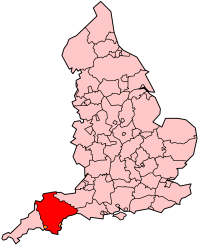 |
|
| Geography | |
| Status | Ceremonial & (smaller) Non-metropolitan county |
| Region | South West England |
| Area - Total - Admin. council - Admin. area |
Ranked 4th 6,707 km² (2,590 sq mi) Ranked 3rd 6,564 km² (2,534 sq mi) |
| Admin HQ | Exeter |
| ISO 3166-2 | GB-DEV |
| ONS code | 18 |
| NUTS 3 | UKK43 |
| Demography | |
| Population - Total (2007 est.) - Density - Admin. council - Admin. pop. |
Ranked 11th 1,135,000 169/km² (438/sq mi) Ranked 12th 750,100 |
| Ethnicity | 98.7% White |
| Politics | |
Devon County Council http://www.devon.gov.uk/ |
|
| Executive | Liberal Democrat |
| Members of Parliament | |
| Districts | |
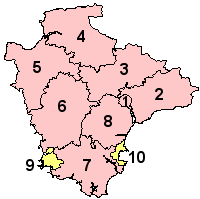
|
|
Devon (pronounced /ˈdɛvən/) is a large county in the South West of England. The county is also referred to as Devonshire, but that is an entirely unofficial name, often indicating a traditional or historical context. The county shares borders with Cornwall to the west and Dorset and Somerset to the east. Its coastline follows the English Channel to the south and the Bristol Channel to the north. It is the only county in England with two separate coastlines.
Devon is the third largest of the English counties and has a population of 1,109,900. The county town is the cathedral city of Exeter, and the county contains two independent unitary authorities: the port city of Plymouth and the Torbay conurbation of seaside resorts, in addition to Devon County Council itself. Plymouth is also the biggest city in Devon. Much of the county is rural (including National Park) land, with a low population density by British standards. 365 square miles (950 km2) are occupied by Dartmoor.
The county is home to part of England's only natural UNESCO World Heritage Site, the Dorset and East Devon Coast, known as the Jurassic Coast for its geology and geographical features. Along with its neighbour, Cornwall, Devon is known as the "Cornubian massif". This geology gives rise to the landscapes of Dartmoor and Exmoor, which are both National Parks. Devon has seaside resorts and historic towns and cities, and a mild climate, accounting for the large tourist sector of its economy.
Contents |
History
Toponymy
The name 'Devon' derives from the name of the Celtic people who inhabited the southwestern peninsula of Britain at the time of the Roman invasion c. 50AD, known as the Dumnonii, thought to mean 'deep valley dwellers'. In the Brythonic Celtic languages, Devon is known as Dyfnaint (Welsh), Devnent in Breton and Dewnans (Cornish).
William Camden, in his 1607 edition of Britannia, described Devon as being one part of an older, wider country that once included Cornwall:
[It] was in ancient time inhabited by those Britains whom Solinus called Dunmonii … . But … the Country of this nation is at this day divided into two parts, known by later names of Cornwall and Denshire …
—William Camden, Britannia.[1]
There is some dispute over the use of 'Devonshire' instead of Devon, and there is no official recognition of the term 'Devonshire' in modern times, except for the name of the Devonshire and Dorset Regiment. One theory is that the 'shire' suffix is due to a mistake in the making of the original letters patent for the Duke of Devonshire, resident in Derbyshire. However, there are references to 'Defenascire' in old English texts from before 1000 AD,[2] which translates to modern English as 'Devonshire'. The term Devonshire may have originated around the 8th century, when it changed from Dumnonia to Defenascir.[3]
Human occupation
Devon was one of the first areas of England settled following the end of the last ice age. Dartmoor is thought to have been settled by Mesolithic hunter-gatherer peoples from about 6000 BC. The Romans held the area under military occupation for around 250 years. Later the area became a frontier between Brythonic Dumnonia and Anglo-Saxon Wessex, and it was absorbed into Wessex by the mid 9th century.
Devon has also featured in most of the civil conflicts in England since the Norman Conquest, including the Wars of the Roses, Perkin Warbeck's rising in 1497, the Prayer Book Rebellion of 1549, and the English Civil War. The arrival of William of Orange to launch the Glorious Revolution of 1688 took place at Brixham.
Devon has produced tin, copper and other metals from ancient times. Devon's tin miners enjoyed a substantial degree of independence through Devon's stannary parliament, which dates back to the twelfth century. The last recorded sitting was in 1748.[4]
Economy and industry
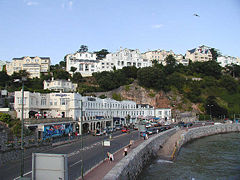
Devon is one of the rural counties, with the advantages and problems characteristic of these. Despite this, the county's economy is also heavily influenced by its two main urban centres, Plymouth and Exeter.
Like neighbouring Cornwall to the west, Devon is disadvantaged economically compared to other parts of southern England, owing to the decline of a number of core industries, notably fishing, mining and farming. Consequently, most of Devon has qualified for the European Community Objective 2 status, particularly around Exmoor, Bideford Bay and the Hartland Point peninsula which is somewhat cut off from industrial Britain due to poor road and rail transport links. These areas of North Devon are, however, only around 50 miles (80 km) by boat from Swansea in Wales. A proposal which has the backing of both the Welsh Assembly Government and the South West Regional Assembly, as well as Devon County Council, is a year-round ferry service from either Ilfracombe or Bideford to Swansea, which it is hoped would stimulate economic growth in both South West Wales and the North coast of Devon and Cornwall.
The 2001 UK foot and mouth crisis harmed the farming community severely.[5] Nearly half of the holdings of the Duchy of Cornwall are in Devon, including a large area of farmland.
Since the rise of seaside resorts with the arrival of the railways in the 19th century, Devon's economy has been heavily reliant on tourism. The county's economy has followed the declining trend of British seaside resorts since the mid 20th century, with some recent revival. This revival has been aided by the designation of much of Devon's countryside and coastline as the Dartmoor and Exmoor national parks, and the Jurassic Coast and Cornwall and West Devon Mining Landscape World Heritage Sites. In 2004 the county's tourist revenue was £1.2 billion.[6]
The attractive lifestyle of the area is drawing in new industries which are not heavily dependent upon geographical location. In 2003, the Met Office, the UK's weather service, moved to Exeter.
Geology, landscape and ecology

Devon is the only county in England to have two separate coastlines; the South West Coast Path runs along the entire length of both, around 65% of which is named as Heritage Coast. Inland, the Dartmoor National Park lies wholly in Devon, and the Exmoor National Park lies in both Devon and Somerset. Apart from these areas of high moorland the county has attractive rolling rural scenery, and villages with thatched cob cottages. All these features make Devon a popular holiday destination. The variety of habitats means that there is a wide range of wildlife (see Dartmoor wildlife, for example). A popular challenge among birders is to find over 100 species in the county in a day. The county's wildlife is protected by the Devon Wildlife Trust, a charity which looks after 40 nature reserves.
The landscape of the south consists of rolling hills dotted with small towns, such as Dartmouth, Salcombe, and Totnes. The towns of Torquay and Paignton are the principal seaside resorts on the south coast. The north of the county is very rural with few major towns except Barnstaple, Great Torrington, Bideford and Ilfracombe. East Devon has the first seaside resort to be developed in the county, Exmouth and the more upmarket Georgian town of Sidmouth, headquarters of the East Devon District Council. Exmouth marks the western end of the Jurassic Coast World Heritage Site.
Devon gave its name to a geological era: the Devonian era, so named by Adam Sedgwick because the distinctive Old Red Sandstone of Exmoor was studied by geologists here. Devon's other major rock system is the carboniferous sandstone which stretches from Bideford to Bude in Cornwall, and contributes to a gentler, greener, more rounded landscape.
Devon's Exmoor coast has the highest cliffs in southern Britain, culminating in the Great Hangman, a 1043 ft (318 m) "hog-backed" hill with an 820 ft (250 m) cliff-face, located near Combe Martin Bay. Its sister cliff is the 716 ft (218 m) Little Hangman, which marks the edge of Exmoor.
One of the features of the North Devon coast is that Bideford Bay and the Hartland Point peninsula are both west-facing, Atlantic facing coastlines; so that a combination of an off-shore (east) wind and an Atlantic swell produce excellent surfing conditions. The beaches of Bideford Bay (Woolacombe, Saunton, Westward Ho! and Croyde), along with parts of North Cornwall and South Wales, are the main centres of surfing in Britain.
Rising temperatures have led to Devon becoming the first place in modern Britain to cultivate olives commercially.[7]
Politics and administration
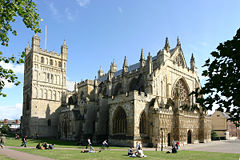
The administrative centre of Devon is the city of Exeter. The largest city in Devon, Plymouth, and the conurbation of Torbay (including Torquay, Paignton and Brixham) have been unitary authorities since 1998 - separate from the remainder of Devon which is administered by Devon County Council for the purposes of local government.
Devon County Council is controlled by the Liberal Democrats,[8] and consists of 33 Liberal Democrats, 23 Conservatives, four Labour and two independent councillors.[9] At a national level, Devon has five Conservative MPs, three Liberal Democrat MPs, and three Labour MPs.
In December 2007, the Department for Communities and Local Government referred Exeter City Council's bid to become a Unitary Council to the Boundary Committee for England, as they felt the application did not meet all their strict criteria. The Boundary Committee was asked to look at the feasibility of a unitary Exeter in the context of examining options for unitary arrangements in the wider Devon county area, and reported back in July 2008 recommending a 'unitary Devon' (excluding Plymouth and Torbay), with a second option of a 'unitary Exeter & Exmouth' (combined) and a unitary 'rest of Devon'. These proposals are out to consultation until September 2008 and the Committee will make final recommendations to the Secretary of State by the end of the year.[10]
Cities, towns and villages
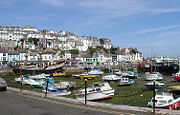
The main settlements in Devon are the cities of Plymouth, a historic port now administratively independent, Exeter, the county town, and Torbay, the county's tourist centre. Devon's coast is lined with tourist resorts, many of which grew rapidly with the arrival of the railways in the 19th century. Examples include Dawlish, Exmouth and Sidmouth on the south coast, and Ilfracombe and Lynmouth on the north. The Torbay conurbation of Torquay, Paignton and Brixham on the south coast is perhaps the largest and most popular of these resorts, and is now administratively independent of the county. Rural market towns in the county include Axminster, Barnstaple, Bideford, Honiton, Newton Abbot, Okehampton, Tavistock, Totnes and Tiverton.
Symbols
Coat of Arms
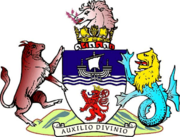
There was no established coat of arms for the county until 1926: the arms of the City of Exeter were often used to represent Devon, for instance in the badge of the Devonshire Regiment. When a county council was formed by the Local Government Act 1888 it was required to adopt a common seal. The seal contained three shields depicting the arms of Exeter along with those of the first chairman and vice-chairman of the council (Lord Clinton and the Earl of Morley).[11]
The county council received a grant of arms from the College of Arms on 11 October 1926. The main part of the shield displays a red crowned lion on a silver field, the arms of Richard Plantagenet, Earl of Cornwall. The chief or upper portion of the shield depicts an ancient ship on wavers, for Devon's seafaring traditions. The Latin motto adopted was Auxilio Divino (by Divine aid), that of Sir Francis Drake. The 1926 grant was of arms alone. On 6 March 1962 a further grant of crest and supporters was obtained. The crest is the head of a Dartmoor Pony rising from a "Naval Crown". This distinctive form of crown is formed from the sails and sterns of ships, and is associated with the Royal Navy. The supporters are a Devon bull and a sea lion. [12] [13]
The County Council adopted a 'ship silhouette' logo after the 1974 reorganisation, adapted from the ship emblem on the coat of arms, but following the loss in 1998 of Plymouth and Torbay re-adopted the coat of arms. In April 2006 the council unveiled a new logo which was to be used in most everyday applications, though the coat of arms will continue to be used for "various civic purposes".[14] [15]
Flag
Devon also has its own flag which has been dedicated to Saint Petroc, a local saint with dedications throughout Devon and neighbouring counties. The flag was adopted in 2003 after a competition run by BBC Devon.[16] The winning design was created by website contributor Ryan Sealey, and won 49% of the votes cast. The colours of the flag are those popularly identified with Devon, for example, the colours of the rugby union team, and the Green and White flag flown by the first Viscount Exmouth at the Bombardment of Algiers (now on view at the Teign Valley Museum), as well as the county's most successful football team, Plymouth Argyle. On 17 October 2006, the flag was hoisted for the first time outside County Hall in Exeter to mark Local Democracy Week, receiving official recognition from the county council[17].
Culture
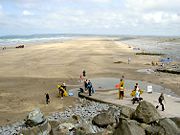
Devon's place names include many with the endings 'coombe/combe' and 'tor' - Coombe being the Brythonic word for 'valley' or hollow (cf Welsh 'cwm') whilst tor derives from a number of Celtic loan-words in English (Old Welsh twrr and Scots Gaelic tòrr) and is used as a name for the formations of rocks found on the moorlands. Its frequency is greatest in Devon, where it is the second most common place name component (after 'ton', derived from the Old English 'tun' meaning farm, village).
Devon has a variety of festivals and practices. One example of these include the flaming tar barrels in Ottery St. Mary, where people who have lived in Ottery for long enough are called upon to celebrate Bonfire Night by running through the village (and the gathered crowds) with flaming barrels of tar on their backs.[18]
The county has given its name to a number of culinary specialities. The Devonshire cream tea, involving scones, jam and clotted cream, is thought to have originated in Devon (though claims have also been made for neighbouring counties); in other countries, such as Australia and New Zealand, it is known as a "Devonshire tea". In New South Wales, Australia, Devon is a name for luncheon meat (processed ham). The name changes in different states of Australia (for example, 'Fritz' in South Australia, 'Polony' in Western Australia) but all describe the same type of meat.
Sport
Devon has been home to a number of customs, such as its own form of wrestling. As recently as the 19th century, a crowd of 17,000 at Devonport, near Plymouth, attended a match between the champions of Devon and Cornwall. Another Devon sport was outhurling which was played in some regions until the 20th century (e.g. 1922, at Great Torrington). Other ancient customs which survive include Dartmoor step dancing, and 'Crying The Neck'.
Devon has three professional football teams, based in each of its three most populated towns and cities. Competing in the Football League Championship, Plymouth Argyle F.C. are the biggest and most successful team in the county whilst Exeter City F.C. play in Football League Two. Torquay United compete in the Conference National. Plymouth's best performance came in 1987 when they finished seventh in the Football League Second Division, while Torquay and Exeter have never progressed beyond the third tier of the league. The county's biggest non-league club is Tiverton Town F.C. which competes in the Southern Football League Premier Division.
Rugby Union is popular in Devon. Two teams — Plymouth Albion and Exeter Chiefs — are, as of 2007, in National Division One. In basketball, Plymouth Raiders play in the British Basketball League. Tamar Valley Cannons, also based in Plymouth, are Devon's only other representatives in the National Leagues. Motorcycle speedway is also supported in the county, with both the Exeter Falcons and Plymouth Devils succeeding in the National Leagues in recent years.
There are four rugby league teams in Devon. Plymouth Titans, Exeter Centurions, Devon Sharks from Torquay and East Devon Eagles from Exmouth. They all play in the Rugby League Conference.
Famous Devonians
Devon is known for its mariners, such as Sir Francis Drake, Sir Humphrey Gilbert, Sir Richard Grenville, Sir Walter Raleigh, and Sir Francis Chichester. The poet Samuel Taylor Coleridge, the crime writer Agatha Christie, the painter and founder of the Royal Academy, Sir Joshua Reynolds, the dog breeder John "Jack" Russell and frontman Chris Martin from the English rock band Coldplay were born in Devon. Matt Bellamy, Dominic Howard and Christopher Wolstenholme from the English band Muse all grew up in Devon. Trevor Francis, former Nottingham Forest and Birmingham City Professional footballer was born and raised in Plymouth.
Education
Devon has a mostly comprehensive education system, except for four grammar schools: in Colyton, Churston, a boys' and a girls' school in Torquay. There are 37 state and 23 independent secondary schools. There are three tertiary (FE) colleges and an agricultural college (Bicton College, near Budleigh Salterton). Torbay has 8 state (with 3 grammar schools) and 3 independent secondary schools, and Plymouth has 17 state (with 3 grammar schools - two female and one male) and 2 independent secondary schools. East Devon and Teignbridge have the largest school populations, with West Devon the smallest (with only two schools). Only one school in Exeter, Mid Devon, Torridge and North Devon have a sixth form - the schools in other districts mostly have sixth forms, with all schools in West Devon and East Devon having a sixth form.
See also
- List of Sites of Special Scientific Interest in Devon
- Roadford Lake
- West Country dialects
- Category:Rivers of Devon
References
- ↑ "William Camden, Britannia (1607) with an English translation by Philemon Holland - Danmonii". www.philological.bham.ac.uk. Retrieved on 2008-03-29.
- ↑ "Manuscript A: The Parker Chronicle". Retrieved on 2007-06-29.
- ↑ Davies, Norman (2000). The Isles: A History. pp. 207. ISBN 0333692837.
- ↑ "Devon's Mining History and Stannary parliament". users.senet.com.au. Retrieved on 2008-03-29.
- ↑ In Devon, the county council estimated that 1,200 jobs would be lost in agriculture and ancillary rural industries — Hansard, 25th April 2001
- ↑ Devon County Council, 2005. Tourism trends in Devon.
- ↑ Paul Simons (2007-05-14). "Britain warms to the taste for home-grown olives". Times Online. Retrieved on 2007-09-20.
- ↑ "English elect councils and mayors", The BBC (2005-05-07). Retrieved on 2008-05-28.
- ↑ Devon County Council, List of Councillors by party affiliation.
- ↑ "Boundary Committee publishes draft proposal for Devon". The Boundary Committee for England (2008-07-07). Retrieved on 2008-07-30.
- ↑ A. C. Fox-Davies, The Book of Public Arms, 2nd edition, London, 1915
- ↑ W. C. Scott-Giles, Civic Heraldry of England and Wales, 2nd edition, London, 1953
- ↑ A brief history of Devon's coat of arms (Devon County Council)
- ↑ Council's designs cause logo row (BBC News)
- ↑ Policy and Resources Overview Scrutiny Committee Minutes, April 3 2006
- ↑ BBC - Devon Community Life - Devon gets its own flag
- ↑ Devon County Council Press Release, 16 October 2006
- ↑ "Ottery Tar Barrels". BBC. Retrieved on 2008-05-14.
External links
- Devon County Council
- BBC Devon
- Discover Devon Local tourist board
- Genuki Devon Historical, geographical and genealogical information
|
|||||
|
|||||
|
||||||||||||||||||||